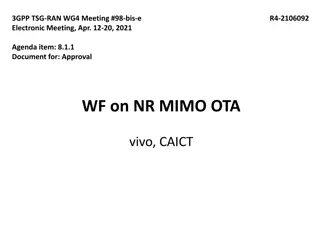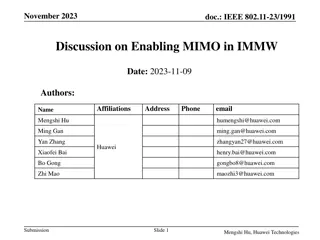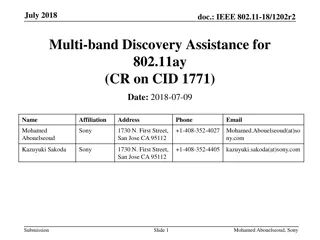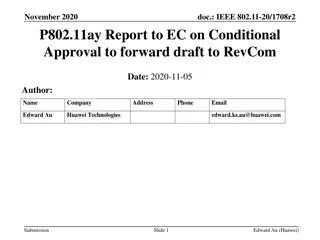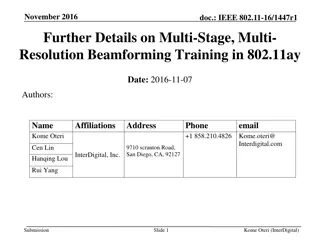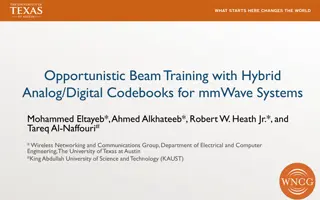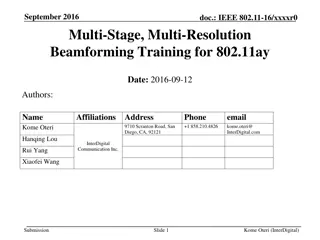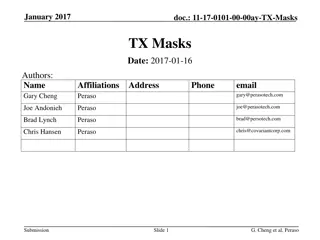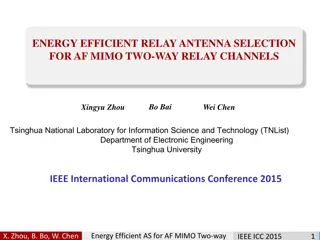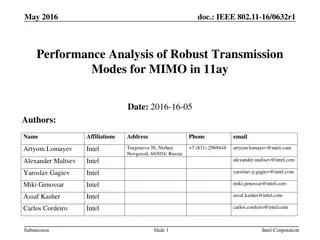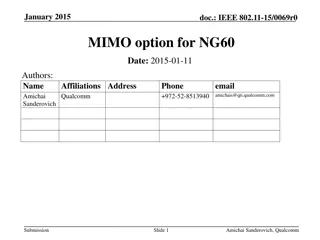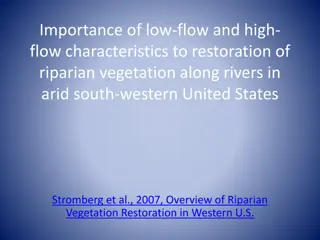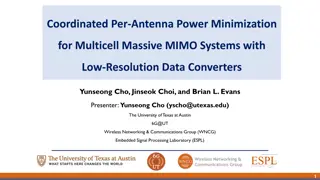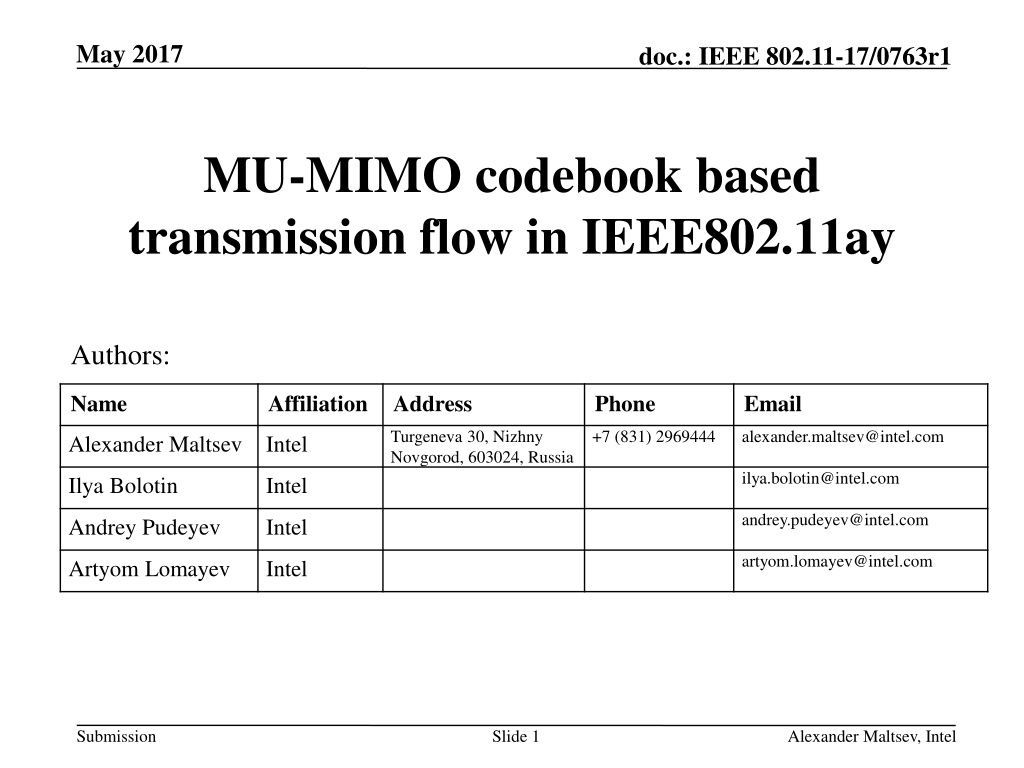
MU-MIMO Codebook Based Transmission Flow in IEEE802.11ay
"Explore the proposed MU-MIMO codebook based transmission flow for IEEE802.11ay, including Enhanced SLS beamforming for extended coverage, beam training, and scheduling procedures. System level simulations demonstrate high throughput MU-MIMO links. Find out more about channel access, transmission flow, and sector estimation in this detailed technical document."
Download Presentation

Please find below an Image/Link to download the presentation.
The content on the website is provided AS IS for your information and personal use only. It may not be sold, licensed, or shared on other websites without obtaining consent from the author. If you encounter any issues during the download, it is possible that the publisher has removed the file from their server.
You are allowed to download the files provided on this website for personal or commercial use, subject to the condition that they are used lawfully. All files are the property of their respective owners.
The content on the website is provided AS IS for your information and personal use only. It may not be sold, licensed, or shared on other websites without obtaining consent from the author.
E N D
Presentation Transcript
May 2017 doc.: IEEE 802.11-17/0763r1 MU-MIMO codebook based transmission flow in IEEE802.11ay Authors: Name Affiliation Address Phone Email Turgeneva 30, Nizhny Novgorod, 603024, Russia +7 (831) 2969444 alexander.maltsev@intel.com Alexander Maltsev Intel ilya.bolotin@intel.com Ilya Bolotin Intel andrey.pudeyev@intel.com Andrey Pudeyev Intel artyom.lomayev@intel.com Artyom Lomayev Intel Submission Slide 1 Alexander Maltsev, Intel
May 2017 doc.: IEEE 802.11-17/0763r1 Abstract This presentation proposes the MU-MIMO codebook based transmission flow for IEEE802.11ay. The flow contains the Enhanced SLS beamforming which provides extended coverage and beam training for both TX and RX of all EDMG STAs. The proposed MU-MIMO transmission flow also contains scheduling procedure. System level simulations have shown that such training is enough accurate to establish MU-MIMO links with high throughputs. Submission 2 Alexander Maltsev, Intel
May 2017 doc.: IEEE 802.11-17/0763r1 MU-MIMO channel access and transmission flow Enhanced SLS Best operating sectors estimation for each AP-STA pair MU Grouping Scheduling & resource allocation MU-MIMO Transmissions AP to STAs MU-MIMO ACK+Feedback: STAs to AP Submission 3 Alexander Maltsev, Intel
May 2017 doc.: IEEE 802.11-17/0763r1 Enhanced SLS BFT allocation Directional CBAP/SP BTI A-BFT DTI BTI DTI Space-time slots Sector ACK DTI BTI A-BFT DMG Beacon Sector ID = 0 DMG Beacon Sector ID = 1 DMG Beacon Sector ID = N-1 . . . Initiator - AP . . . L- L-STF L-CE Data AGC TRN-R Header Omni RX TRN-R field Responder EDMG STA X Far away STAs Responder EDMG STA Y Responder EDMG STA Z Responder DMG STA L R-TXSS Submission 4 Alexander Maltsev, Intel
May 2017 doc.: IEEE 802.11-17/0763r1 MU Grouping and Scheduling During Enhanced SLS EDMG STA reports to PCP/AP several best sectors defined during BTI to give the PCP/AP scheduler more flexibility in MU grouping. The Destination AID field of the Allocation field of the Extended Schedule element may contain the Group ID. To associate a Group ID with a group of STAs a EDMG Group ID Set element is already defined in D0.3 (9.4.2.254 EDMG Group ID Set element). It should be sent together with Extended Schedule element in DMG Beacon or Announce frames. But the EDMG Group fields in the EDMG Group ID Set element should contain not only the STAs AIDs but also the indexes of the AP TX sectors (from the best sectors reported by STAs) which will be used by the AP for transmission to each STA in MU mode of operation. Octets 1 1 1 1 11 11 Element ID Extension Number of EDMG Groups EDMG Group 1 EDMG Group 2 ... Element ID Length STA 0 STA 1 STA 7 EDMG Group ID AID 0 AP TX sector ID AID 1 AP TX sector ID AID 7 AP TX sector ID ... Bits 8 8 2 8 2 8 2 Submission 5 Alexander Maltsev, Intel
May 2017 doc.: IEEE 802.11-17/0763r1 DL MU-MIMO transmission flow AP reserves space-time slots for ACK and feedback for each STA. Timing and order of ACK transmission follows the order of STAs in EDMG Group fields. SP1 (EDMG Group 1) SP2 (EDMG Group 2) AP DATA DATA DATA STA4 STA4 STA3 STA2 STA2 STA2 STA1 STA1 EDMG STA1 ACK 1 ACK 1 FB1 FB1 ACK 2 ACK 2 EDMG STA2 ACK 2 FB2 FB2 FB2 EDMG STA3 ACK 3 FB3 EDMG STA4 ACK 4 ACK 4 FB4 FB4 Submission 6 Alexander Maltsev, Intel
May 2017 doc.: IEEE 802.11-17/0763r1 System level simulations To demonstrate that codebook-based AWVs, obtained during the Enhanced SLS BF phase, are enough accurate to establish MU-MIMO links with high throughputs, the system level simulations based on IEEE 802.11ad OFDM PHY were carried out. The comparison between two types of antenna systems configurations and beamforming was done: 2D DFT codebook for 8x16 antenna array Full adaptive antenna (FAA) array with SVD-based wideband beamforming and scheduling Multi-Stream Phased Antenna Array (MS PAA) with codebook-based wideband beamforming and scheduling (2D DFT codebook was used) Submission 7 Alexander Maltsev, Intel
May 2017 doc.: IEEE 802.11-17/0763r1 System level simulator parameters Isolated small cell with three APs (antenna height - 6m) each serving its own 120 sector and operating in its own channel (Frequency reuse-3) Users are placed randomly (with uniform distribution) within the cell considering 50 users per cell sector Parameters Deployment Assumption 1 2 Open area, Street canyon, Hotel lobby Quasi-Deterministic Open area, Street canyon, Hotel lobby 60 GHz / 2,16 GHz 6m 8x16 elements 19 dBm 26 dBi 1.5m Omni, 0 dBi DL MU-MIMO w TPC 3 Channel model Carrier / BW Open area scenario deployment assumptions Height AP UE drop area Configuration TX power Gain Height Gain antenna array 100m Wrap-around to left side AP sector broadside 6m UE drop area STA antenna Two APs are mounted at each lamppost serving two sectors (frequency reuse-2) along the sidewalk. Users are placed randomly (uniform distribution) within the sidewalks considering 45 users per each AP sector Transmission scheme Street canyon scenario deployment assumptions FAA/Wideband SVD based MS PAA/Codebook-based 2D DFT Access point AP antenna array type/BF One AP, mounted at the center of the shortest side, has a single sector, directed to the center of the lobby Users are randomly (with uniform distribution) within the lobby area 0,2m FAA 128 MS PAA 8 Number of RF chains STA drop area 15.0m placed Channel estimation Perfect 5,0m Type Greedy PF MU scheduling Full buffer Scheduling 20.0m Traffic load Hotel lobby scenario deployment assumptions Submission Slide 8 Alexander Maltsev, Intel
May 2017 doc.: IEEE 802.11-17/0763r1 Simulation results AP antenna array model and beamforming scheme AP throughput, Gbps Avg. user throughput, Mbps Cell-edge user throughput, Mbps Avg. size of MU group Scenario 10.2 205 144 222 173 848 575 107 70 81 75 484 367 4.8 3.8 2.5 2.3 4.5 3.5 FAA/Wideband SVD Open area 7.2 (-29%) 10.0 7.8 (-22%) 17.0 11.5 (-32%) MS PAA/Codebook based FAA/Wideband SVD Street canyon MS PAA/Codebook based FAA/Wideband SVD Hotel lobby MS PAA/Codebook based The system level simulations for DL MU-MIMO mode in main large area dense environments have shown that the MS PAA codebook-based 2D DFT wideband beamforming (which can be realized by using the proposed transmission flow) demonstrates acceptable degradation (20- 30%) comparing to the FAASVD-based wideband beamforming. Note: FAA array requires a number of RF chains equal to the number of antenna array elements (here 128), while the MS PAA requires the number of RF chains equal to the number of streams (which here was limited by 8). Submission 9 Alexander Maltsev, Intel
May 2017 doc.: IEEE 802.11-17/0763r1 Simulation results Figures below demonstrate the average number of STA in MU group in codebook-based MU-MIMO versus the number of best AP TX sectors reported to AP by each STA As it can be seen from the simulation results, for efficient MU-MIMO grouping it is sufficient for EDMG STA to report only two AP TX sectors, received by EDMG STA with best quality in BTI. It may give up to 8% throughput increasing in complex multipath channels. Submission 10 Alexander Maltsev, Intel
May 2017 doc.: IEEE 802.11-17/0763r1 SP/M #1 Do you agree to include to the spec draft the text: EDMG Group fields of EDMG Group ID Set element should contain the STAs AIDs and the corresponding indexes of the AP TX sectors (chosen from the best sectors reported by STAs), which may be used by the AP for transmission to each STA in MU mode of operation. Submission 11 Alexander Maltsev, Intel

